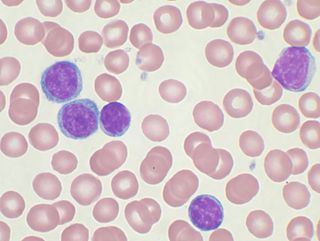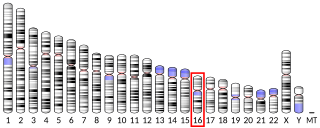Bruton's tyrosine kinase (abbreviated Btk or BTK), also known as tyrosine-protein kinase BTK, is a tyrosine kinase that is encoded by the BTK gene in humans. BTK plays a crucial role in B cell development.
Bruton's tyrosine kinase (abbreviated Btk or BTK), also known as tyrosine-protein kinase BTK, is a tyrosine kinase that is encoded by the BTK gene in humans. BTK plays a crucial role in B cell development.
BTK contains five different protein interaction domains. These domains include an amino terminal pleckstrin homology (PH) domain, a proline-rich TEC homology (TH) domain, SRC homology (SH) domains SH2 and SH3, as well as a protein kinase domain with tyrosine phosphorylation activity. [5]

Part of the TH domain is folded against the PH domain while the rest is intrinsically disordered.

BTK plays a crucial role in B cell development as it is required for transmitting signals from the pre-B cell receptor that forms after successful immunoglobulin heavy chain rearrangement. [6] It also has a role in mast cell activation through the high-affinity IgE receptor. [7]
BTK contains a PH domain that binds phosphatidylinositol (3,4,5)-trisphosphate (PIP3). PIP3 binding induces BTK to phosphorylate phospholipase C (PLC), which in turn hydrolyzes PIP2, a phosphatidylinositol, into two second messengers, inositol triphosphate (IP3) and diacylglycerol (DAG), which then go on to modulate the activity of downstream proteins during B-cell signalling. [8]
Mutations in the BTK gene are implicated in the primary immunodeficiency disease X-linked agammaglobulinemia (Bruton's agammaglobulinemia); sometimes abbreviated to XLA and selective IgM deficiency. [9] Patients with XLA have normal pre-B cell populations in their bone marrow but these cells fail to mature and enter the circulation. The BTK gene is located on the X chromosome (Xq21.3-q22). [10] At least 400 mutations of the BTK gene have been identified. Of these, at least 212 are considered to be disease-causing mutations. [11]
BTK is important for the survival and proliferation of leukemic B cells, which motivated efforts to develop BTK inhibitors as treatments for B cell malignancies such as mantle cell lymphoma (MCL) and chronic lymphocytic leukemia (CLL). [12] As BTK is also linked to autoimmune disorders, [13] [14] recent efforts have sought to evaluate BTK inhibition as a therapeutic strategy for treatment of diseases such as multiple sclerosis (MS) and rheumatoid arthritis (RA). [15]
Approved drugs that inhibit BTK:
Various drugs that inhibit BTK are in clinical trials: [24]
Bruton's tyrosine kinase is named for Ogden Bruton, who first described XLA in 1952. [10] [40] Later studies in 1993 and 1994 reported the discovery of BTK (initially termed B cell progenitor kinase or BPK) and found that BTK levels are reduced in B cells from XLA patients. [41] [42] [43]
Bruton's tyrosine kinase has been shown to interact with:

Chronic lymphocytic leukemia (CLL) is a type of cancer in which the bone marrow makes too many lymphocytes. Early on, there are typically no symptoms. Later, non-painful lymph node swelling, feeling tired, fever, night sweats, or weight loss for no clear reason may occur. Enlargement of the spleen and low red blood cells (anemia) may also occur. It typically worsens gradually over years.

Bcl-2, encoded in humans by the BCL2 gene, is the founding member of the Bcl-2 family of regulator proteins. BCL2 blocks programmed cell death (apoptosis) while other BCL2 family members can either inhibit or induce it. It was the first apoptosis regulator identified in any organism.

X-linked agammaglobulinemia (XLA) is a rare genetic disorder discovered in 1952 that affects the body's ability to fight infection. As the form of agammaglobulinemia that is X-linked, it is much more common in males. In people with XLA, the white blood cell formation process does not generate mature B cells, which manifests as a complete or near-complete lack of proteins called gamma globulins, including antibodies, in their bloodstream. B cells are part of the immune system and normally manufacture antibodies, which defend the body from infections by sustaining a humoral immunity response. Patients with untreated XLA are prone to develop serious and even fatal infections. A mutation occurs at the Bruton's tyrosine kinase (Btk) gene that leads to a severe block in B cell development and a reduced immunoglobulin production in the serum. Btk is particularly responsible for mediating B cell development and maturation through a signaling effect on the B cell receptor BCR. Patients typically present in early childhood with recurrent infections, in particular with extracellular, encapsulated bacteria. XLA is deemed to have a relatively low incidence of disease, with an occurrence rate of approximately 1 in 200,000 live births and a frequency of about 1 in 100,000 male newborns. It has no ethnic predisposition. XLA is treated by infusion of human antibody. Treatment with pooled gamma globulin cannot restore a functional population of B cells, but it is sufficient to reduce the severity and number of infections due to the passive immunity granted by the exogenous antibodies.

Phosphatidylinositol-4,5-bisphosphate 3-kinase catalytic subunit delta isoform also known as phosphoinositide 3-kinase (PI3K) delta isoform or p110δ is an enzyme that in humans is encoded by the PIK3CD gene.

ZAP-70 is a protein normally expressed near the surface membrane of lymphocytes. It is most prominently known to be recruited upon antigen binding to the T cell receptor (TCR), and it plays a critical role in T cell signaling.

Tyrosine-protein kinase SYK, also known as spleen tyrosine kinase, is an enzyme which in humans is encoded by the SYK gene.

B-lymphocyte antigen CD19, also known as CD19 molecule, B-Lymphocyte Surface Antigen B4, T-Cell Surface Antigen Leu-12 and CVID3 is a transmembrane protein that in humans is encoded by the gene CD19. In humans, CD19 is expressed in all B lineage cells. Contrary to some early doubts, human plasma cells do express CD19. CD19 plays two major roles in human B cells: on the one hand, it acts as an adaptor protein to recruit cytoplasmic signaling proteins to the membrane; on the other, it works within the CD19/CD21 complex to decrease the threshold for B cell receptor signaling pathways. Due to its presence on all B cells, it is a biomarker for B lymphocyte development, lymphoma diagnosis and can be utilized as a target for leukemia immunotherapies.

Phosphoinositide 3-kinase inhibitors are a class of medical drugs that are mainly used to treat advanced cancers. They function by inhibiting one or more of the phosphoinositide 3-kinase (PI3K) enzymes, which are part of the PI3K/AKT/mTOR pathway. This signal pathway regulates cellular functions such as growth and survival. It is strictly regulated in healthy cells, but is always active in many cancer cells, allowing the cancer cells to better survive and multiply. PI3K inhibitors block the PI3K/AKT/mTOR pathway and thus slow down cancer growth. They are examples of a targeted therapy. While PI3K inhibitors are an effective treatment, they can have very severe side effects and are therefore only used if other treatments have failed or are not suitable.

Ibrutinib, sold under the brand name Imbruvica among others, is a small molecule drug that inhibits B-cell proliferation and survival by irreversibly binding the protein Bruton's tyrosine kinase (BTK). Blocking BTK inhibits the B-cell receptor pathway, which is often aberrantly active in B cell cancers. Ibrutinib is therefore used to treat such cancers, including mantle cell lymphoma, chronic lymphocytic leukemia, and Waldenström's macroglobulinemia. Ibrutinib also binds to C-terminal Src Kinases. These are off-target receptors for the BTK inhibitor. Ibrutinib binds to these receptors and inhibits the kinase from promoting cell differentiation and growth. This leads to many different side effects like left atrial enlargement and atrial fibrillation during the treatment of Chronic Lymphocytic Leukemia.
FCM, or FMC in the context of chemotherapy is an acronym for a chemotherapy regimen that is used in the treatment of indolent B cell non-Hodgkin's lymphomas. In combination with Rituximab, this regimen is called R-FCM or R-FMC, or FCM-R, FMC-R.

Acalabrutinib, sold under the brand name Calquence, is a medication used to treat various types of non-Hodgkin lymphoma, including mantle cell lymphoma (MCL) and chronic lymphocytic leukemia/small lymphocytic Lymphoma (CLL/SLL). It may be used both in relapsed as well as in treatment-naive settings.

Entospletinib is an experimental drug for the treatment of various types of cancer under development by Gilead Sciences. It is an inhibitor of spleen tyrosine kinase (Syk). It has entered clinical trials for acute myeloid leukaemia (AML), chronic lymphocytic leukemia (CLL), diffuse large B cell lymphoma (DLBCL), graft-versus-host disease (GvHD), hematological malignancies, mantle cell lymphoma (MCL), and non-Hodgkin lymphoma (NHL).
Owen Witte is an American physician-scientist at the University of California, Los Angeles. He is a University Professor of microbiology, immunology and molecular genetics in the David Geffen School of Medicine at UCLA, founding director emeritus of the UCLA Eli and Edythe Broad Center of Regenerative Medicine and Stem Cell Research, and the UC Regents’ David Saxon Presidential Chair in developmental immunology (1989–present). Witte is also a Howard Hughes Medical Institute investigator (1986–2016) and a member of the President's Cancer Panel, the National Academy of Sciences, the National Academy of Medicine, the American Academy of Arts and Sciences, and the Cancer Research Academy of the AACR. He serves on numerous editorial boards and scientific advisory boards for academic centers and biotechnology companies.
Clonal hypereosinophilia, also termed primary hypereosinophilia or clonal eosinophilia, is a grouping of hematological disorders all of which are characterized by the development and growth of a pre-malignant or malignant population of eosinophils, a type of white blood cell that occupies the bone marrow, blood, and other tissues. This population consists of a clone of eosinophils, i.e. a group of genetically identical eosinophils derived from a sufficiently mutated ancestor cell.

Umbralisib, sold under the brand name Ukoniq, is an anti-cancer medication for the treatment of marginal zone lymphoma (MZL) and follicular lymphoma (FL). It is taken by mouth.

Zanubrutinib, sold under the brand name Brukinsa, is an anticancer medication used for the treatment of mantle cell lymphoma (MCL), Waldenström's macroglobulinemia (WM), marginal zone lymphoma (MZL), and chronic lymphocytic leukemia (CLL). Zanubrutinib is classified as a Bruton's tyrosine kinase (BTK) inhibitor. It is given by mouth.
BeiGene, Ltd. is a China-based drug developer. It specializes in the development of drugs for cancer treatment. Founded in 2010 by chief executive officer John V. Oyler and Xiaodong Wang, the company is headquartered in Cambridge, Massachusetts and has offices in North America, Europe, South America, Asia and Australia. BeiGene has a large presence in the Chinese market. BeiGene has developed several pharmaceuticals, including tislelizumab, a checkpoint inhibitor, and zanubrutinib, a Bruton's tyrosine kinase inhibitor.

Pirtobrutinib, sold under the brand name Jaypirca, is an anticancer medication that is used to treat mantle cell lymphoma. It inhibits B cell lymphocyte proliferation and survival by binding and inhibiting Bruton's tyrosine kinase (BTK). It is taken by mouth.

Nemtabrutinib is a small molecule drug that works as a reversible Bruton's tyrosine kinase (BTK) inhibitor; unlike other BTK inhibitors it also works against some mutated forms of BTK. Merck paid $2.7 billion to acquire the company ArQule and the drug, which is being investigated as a cancer treatment.

Orelabrutinib is a drug for the treatment of cancer.